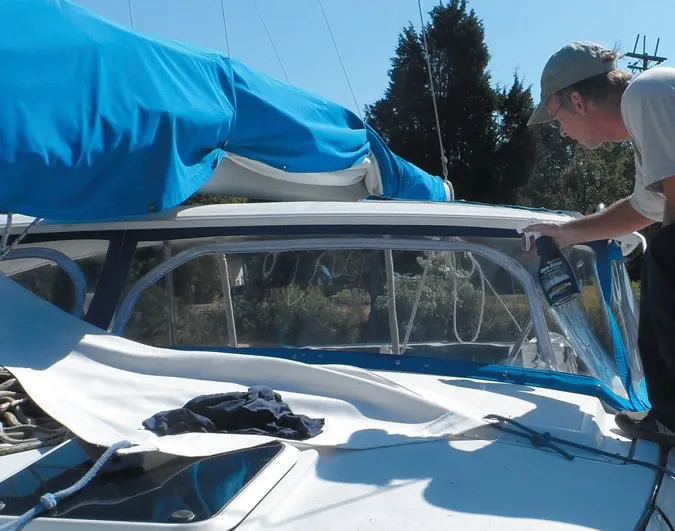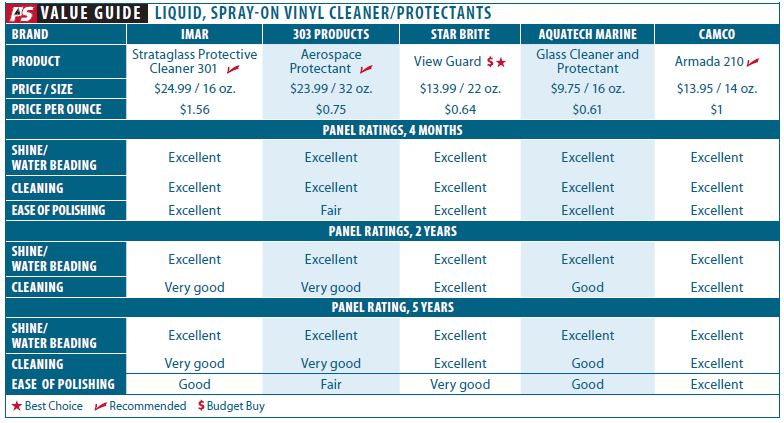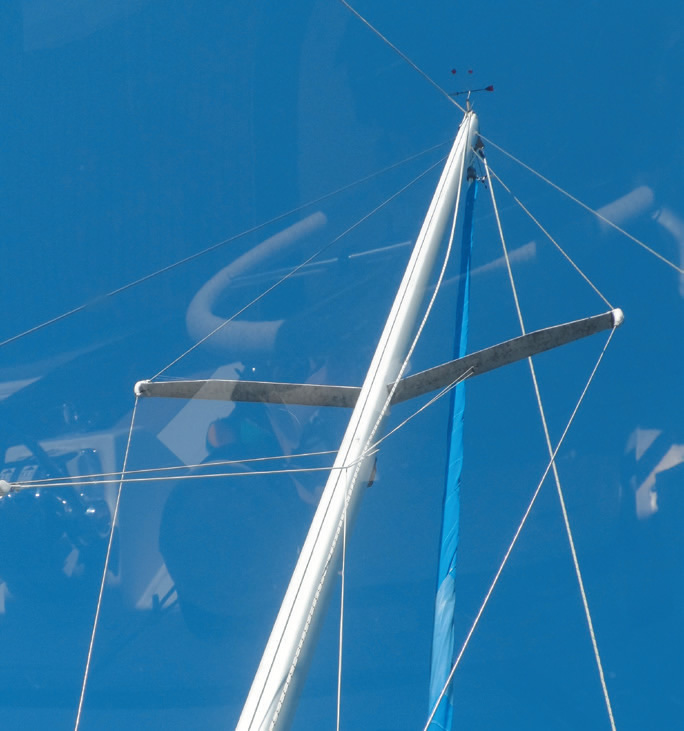When the clear vinyl on one of our multihull test boats began to crack and fade after approximately 10 years, the costs estimates for window replacement began at around $1,500. Thus began our investigation into ways to prolong the life of clear plastics. In previous issues weve reported findings at the six-month and two-year marks. Here, we present a last look at products and best practices to preserve clear plastics, and the five-year performance of four popular types of clear plastic in the marine environment.
What We Tested
There are two classes of protectants: spray cleaners that are applied every few weeks and creams or pastes applied quarterly. The sprays focus on cleaning and shine, and all claim some UV protection. The creams and pastes clean more completely, provide a more substantial film and require more effort.
There are also several manufacturers and two classes of vinyl window materials. Our testing is centered on two premium coated products (OSea and Strataglass) and two products (Regalite and Crystal Clear) that are less expensive, uncoated versions of the premium products.
Finally, we observed the aging of unknown vinyl samples that had been restored using either packaged kits or the protectants tested in this review.

Photos by Drew Frye
How We Tested
Testers placed 40 8-by-10-inch panels of flexible window material at an outside site exposed to the sun, wind, and weather in the Chesapeake Bay area. Some were left untreated, two were fitted with Sunbrella covers, and the rest were treated by an assortment of waxes or sprays.
Test samples included Strataglass 40 mil thickness, Strataglass 30 mil, Regalite 40 mil, Crystal Clear 30 mil, OSea 30 mil, and Osea 40 mil. One panel of each product was left untreated, one Strataglass panel and one Regalite panel were covered by a Sunbrella flaps and not treated, and the rest were treated with various combinations of protective sprays and pastes. We applied spray cleaner/protectant products every 30 days, and cream/paste products every 90 days. We kept one control set indoors in a dark, temperature controlled environment.
At the six-month, two-year, and five-year marks, testers evaluated each panel for opacity and flexibility. At the end of five years, testers cut the samples and compared their flexibility to new materials at 74F, 34F, and 0F. For an on-the-water comparison, two products were used on our test boat.
For a detailed description of the testing protocols please PS Protecting Clear Vinyl Windows, January 2014. The window materials were compared in PS How do Different Vinyl Types Compare? January 2014.
Observations
Clear plastic is very vulnerable to cold. Several samples were shattered-not torn-by falling ice during winter storms. At the 2-year mark, one reconditioned panel cracked while testers were carefully cleaning it at 45F. After that event, we never treated the samples at temperatures less than 65F. Reconditioned panels are stiffer than new panels, and although some products claim to restore flexibility to old panels, our tests did not confirm these claims.
Humidity. The restoration and maintenance regimen eliminated stickiness on the older, restored panels, but it could not protect them from hazing in humid conditions. Among these older, restored panels, the difference between treated and untreated panels was clearly apparent at times of high humidity. The restored panels became hazy during sustained rainy weather, and for up to 12 hours afterward, if not maintained by a regular protectant program. The tendency to haze increased over the years. Even morning dew caused a haze that did not go away for several hours.
Factory-coating. Factory-coated and uncoated vinyl products are effectively indistinguishable when new. The uncoated vinyl is considerably more flexible, but visibility and haze resistance is roughly equal. However, after five years of exposure, the uncoated Crystal Clear and Regalite have become more vulnerable to humidity hazing in sustained damp weather.
Stiffness. Factory-coated materials, such as Strataglass and OSea, are considerably stiffer than their uncoated counterparts, Crystal Clear and Regalite. Strataglass is considerably stiffer than OSea. However, Evaluated at 75F, 34F, and 0F, none of the panels stiffened measurably in 5 years.
Polishes. All of the polishing products improved water beading for about three months, with Imar Protectant, Starbrite View Guard, and Starbrite Clear fairing best. All of the polishes reduced weather-induced fogging, although differences between products were very difficult to discern. When applied as directed, none of the protectants caused damage to the vinyl. The problems came with more abrasive products used in restoration.
Micro-abrasive polishes. We took two panels of Strataglass 40 mil and polished them with a fine compound to a high sheen. The polishing speed and time was the same as that used to restore old vinyl. The resulting shine, without wax, was equivalent to new vinyl.
However, as time passed, this changed. Almost immediately, the tendency to fog increased, and after five years the panel had the opacity and stiffness of panels 10 years older. We suspect that the micro-scratches caused by polishing allowed higher levels of oxygen and moisture to penetrate the surface.
It is important to recognize that if you polish out a bad spot on your new vinyl window, you are now committed to a regular regimen of sealing with wax for the lifetime of the window. Thus, our recommendation is to postpone polishing soft vinyl with restoration compounds until the only alternative is replacement. Better to have a single scratch you can ignore, than a fogged area you can’t see through.
Cover-only. After five years, the covered panel, freshly waxed, was indistinguishable from brand-new – matching our best-performing treated panel. In our view, covering the windows is the best strategy. If possible, low awnings or covers that don’t make contact with the plastic are preferable. Any cover should also protect against sun reflecting up off the deck
Cream Polishes
For best results, follow the instructions. Some tell us to the let the product dry to a haze before buffing; others are to be wiped off immediately.
Imar Strataglass Protective Polish
This cream-type cleaner wax is the only polish endorsed by Strataglass for use during the warranty period. It easily produced a mirror gloss and is among the most effective products for restoring gloss to vinyl.
Bottom line: It is expensive, but it is only used a few times each year. This was our Best Choice.
Star Brite Clear
A cream-type cleaner wax, Star brite Clear is Part 2 of a two-step vinyl restoration system.
Bottom line: Star brite Clear polishes easy and has good water beading durability. Recommended.
EisenShine Protectant
This protectant, also sold separately, is part of a multi-step restoration process. It produces a good shine, repels dirt, and beads water as well as the others. The complete kit includes 4 ounces each of cleaner, stripper (compound), protectant, plus instructions and an applicator pad for stripping.
Bottom line: This protectant worked as advertised and is Recommended.
Sudbury Step 2
For a thin liquid, Sudburys Step 2 provides a great shine and seems to last well.
Bottom line: The eight-ounce bottle goes further than others of the same volume. Recommended.
Novus 1
Another thin liquid, Novus 1, went on easy and performed well, yielding excellent results.
Bottom line: Easy to use, and with an affordable price tag, Novus 1 is rated a Budget Buy.
Cleaner/Protectants
All of the cleaner/protectants helped preserve clarity of clear plastic by protecting against moisture and dirt. Claims of protection against UV exposure could not be confirmed by our test methods.
Imar Strataglass Protective Cleaner
Endorsed by Strataglass as the only acceptable cleaner during the warrantee period, Imar is certainly a safe bet, though not quite the best cleaner.
Bottom line: Effective, but the most expensive of the bunch. Recommended.
Star Brite View Guard
Hands down, this was the easiest to use of the group, and polishes to a nice shine. This product stood out in its ability to sheet the water off, improving wet weather visibility.
Bottom line: A top performer that wont break the bank, this was our Budget Buy and Best Choice in this category.
303 Aerospace Protectant
Performing at about the same level as Imar spray protectant, 303 Aerospace Protectant cleaned well, but took a little longer to polish.
Bottom line: A brand with a strong following in the marine field, 303 does not disappoint here. Recommended.
Aqua Tech Glass Cleaner and Protectant
A reasonably effective spray product that has performed well in earlier Practical Sailor tests, Aquatech provided some water repellency and polished easily. Beading did not last as long as some other products.
Bottom line: There are better choices.
Armada 210
The sole aerosol in the line-up, Armada was recommended to us by several canvas shops. It is their go-to product when a customer brings in a filthy dodger for repair and restoration. We were warned that solvents in the spray might harm the material, but Armanda products have proven safe.
Bottom line: This was the most effective cleaner for dirty vinyl. Recommended.
Conclusions
Protectants reduce internal hazing due to high humidity, particularly in restored and older, non-coated vinyls. The protectants reduce dirt buildup, bead water, and prevent hazing in humid weather. Star brite View Guard proved particularly effective at all three tasks. Our tests could not prove or disprove any claims about UV protection.
Coated vinyl (OSea and Strataglass) substantially outperformed uncoated vinyl (Regalite, Crystal Clear, and restored vinyls) in humid conditions, and, for this reason, are worth the extra expense. Its not apparent whether coated products actually last longer, and they are certainly less flexible. For fixed windows, flexibility probably makes little difference, but we recommend either OSea or uncoated products for windows that must be rolled-up in use, using either 20 or 30 mil thickness. Save the 40 mill products and Strataglass for windows that never move.
Covers are very effective if you can keep them from flapping against the vinyl. They keep the windows clean without having to touch them. Micro-scratches from excessive cleaning are a common cause of blurry clear plastic.
All of the cleaner/protectants produced an acceptable shine, with Armada 210 rating best as a cleaner. Among the cream and wax protectants, Imar Protectant led the field, producing a smoother feel and longer-lasting water repellency. Star brite View Guard excelled as a cleaner and noticeably improved visibility in rainy weather by sheeting the water. Covers provide the very best protection, supplemented by occasional use of an effective wax or spray protectant. Covers are also the only effective preventative for reflected UV damage.
With care and proper protection, a high-quality, clear plastic window that is kept covered and carefully maintained can last 20 years. By comparison, plastic that is renewed and polished with fine compound at frequent intervals is unlikely make it past five.
Any abrasive restoration should be used only as a last resort. Some things are better left alone.



Our long-term test of clear vinyl and clear-vinyl treatments includes environmental outdoor tests with controls, as well as some real-world testing on one of our test boats. In the process weve learned about many things the hard way.
Never use paper towels for cleaning or polishing. Although some batches may be acceptable, many will contain grit or wood fibers large enough to scratch windows. We used freshly laundered cotton knit for all of the sample testing.
Treat both sides of every window, every time. While it might seem that only the outside needs treatment, moisture absorption affects both surfaces. Samples that were treated on only one side sometime suffered from internal fogging in damp weather.
Wipe any accumulated and dried crud off the container spout before you start. Even abrasive-free products sometimes attract grit.
Never polish or clean windows at temperatures below 65F. This is a firm rule as the panels pass the 5-year mark. We lost two panels to low temperature brittleness.



































